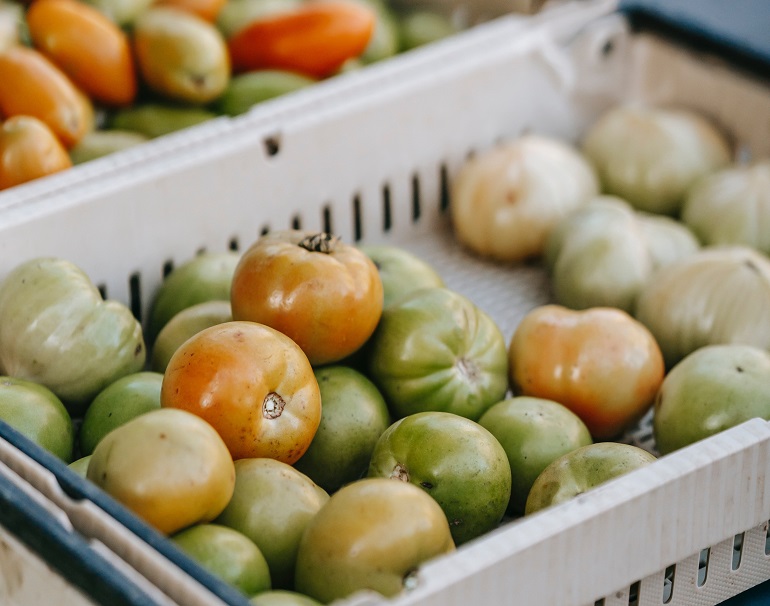How to store tomatoes to minimize post-harvest losses

This post is also available in:
This post is also available in:
![]() Français (French)
Français (French) ![]() Deutsch (German)
Deutsch (German) ![]() العربية (Arabic)
العربية (Arabic) ![]() 简体中文 (Chinese (Simplified))
简体中文 (Chinese (Simplified)) ![]() Ελληνικά (Greek)
Ελληνικά (Greek) ![]() Português (Portuguese (Brazil))
Português (Portuguese (Brazil))
The tomato is one of the most famous and widely used fruit and vegetables globally. In order to protect and increase the final yield of their crop, growers (whether cultivating tomatoes in an open-field, in low-cover tunnels, or in a greenhouse) focus on optimizing some cultivation techniques such as sowing, irrigation, fertilization, and plant protection. Although in many cases, the desired fruit yield is achieved in the field, a substantial proportion of the production is lost after the harvest (in storage and transportation) due to improper handling of the product. Based on worldwide studies, postharvest losses in tomato amount to 5-25% in developed countries and 20 to 50% in developing countries (Kader et al., 1985, 1992). Inappropriate preservation of the product may also have a negative impact on its quality characteristics (color, aroma, flavor, firmness, etc.), reducing its final commercial value. In order to minimize these losses and protect the quality characteristics of tomatoes, I advise producers to take into account and follow the steps-principles, analyzed below when storing their product until it reaches the end market.
Vital tips for preserving tomatoes
How to preserve tons of produce
Immediately after the fruit is harvested, it needs to be quickly pre-cooling (1) to 14 oC (57 oF) and kept cool at every stage of the process.
Dynamic cooling (2) is essential for preserving the produce.
Do not store tomatoes together with products that produce large amounts of ethylene, such as apples, pears, peaches, nectarines, etc., since tomatoes are very sensitive to ethylene. The storage temperature should be kept within the recommended levels to avoid physiological damage to the fruit. As a general rule, tomatoes should be preserved at 12-14 oC (53-57 oF) and 85% relative humidity. In this environment, the fruit can be successfully stored for 2 to 4 weeks. In some cases, growers can adjust the storage temperature to slightly higher levels when storing green (but ripe) fruits.
On the contrary, under no circumstances should tomatoes be exposed to temperatures below 8 oC (46.4 oF), as the fruit is susceptible to chilling, and symptoms of physiological freezing (internal crystallization) disorders may occur. Remember that the temperature and stage of ripening of the fruit will also affect its storage life. For example, a green tomato stored at 14 oC (57 oF) can be kept for a longer period of time (up to 28 days) than a ripe red tomato that can only last 2-4 days under the same conditions.
I advise you to treat your tomatoes with ethylene (3) in specifically designed chambers by supply sufficient ethylene to create a constant concentration of 100 – 150 ppm until this process is completed. Additionally, you should manage carbon dioxide (CO2) because it will extend the preservation time, protecting the quality of the product.
Store tomatoes based on the lowest threshold of natural color and ripeness. (third green stage of physiological ripeness) and then placed in dynamic desiccators, as stated earlier.
At harvest, tomatoes must be firm, healthy, and free of foreign taste or odor, as well as healed injuries, rot, and pesticide residue or mold. Also, ensure there are no disease or insect infestations on the harvested fruits.
Inside the cold room:
The temperature should be evenly distributed, and cooling should be achieved by cool air moving at low speeds and with a laminar flow at each point in the chamber.
Placing tomatoes in cold chambers-rooms:
- Products should be placed in packages that are very well-ventilated to allow circulation of cold air and achieve better cooling (leave gaps of 5 to 10 cm or 2-4 inches between pallets).
- The products should occupy the refrigerated area, leaving appropriate gaps at the position of the air coolers and, on the opposite side, leaving a gap of 30 cm or 12 inches.
- The products should be stored in such a way as to leave a suitable gap underneath them (this creates uniformity in the concentration of carbon dioxide (CO2) and better management of carbon dioxide, which is heavier than the other gases and occupies the lower parts of the refrigeration chamber. (use of palletizers, shelves, pallets, etc.).
- The storage of products should be such that the level of the upper side of the storage boxes does not show projections or recesses, resulting in uneven cold airflow.
- Leave a suitable gap between the ceiling and the final storage level to prevent the freezing of the products. The maximum storage height in refrigerated compartments should provide a gap from the ceiling equal to or greater than one-tenth of the width of the compartment.
- Do not store contaminated products in the same space as healthy products.
Finally, even when the storage conditions are ideal, performing a frequent inspection of the product (and the facilities) is highly recommended to ensure that there is no disease infection or chilling injuries. In case you find a damaged-infected fruit, remove it immediately from the batch.
The above principles can and should, to a large extent, also be adopted when transporting the product, especially over long distances.
You can find additional information on the proper preservation and storage of tomatoes in the book “Vegetables Long-Term Preservation: The Secrets”.
Notes
- Pre-cooling is the rapid process of removing heat from products (usually right after harvest). This heat has been generated a) by the changing respiration of the plant and b) by the ambient temperature during harvesting and storage.
- Dynamic cooling is a necessary technique for products with long preservation or for particularly sensitive products, e.g. pears, kiwis, apples, plums, nectarines, peaches, apricots, etc. It is based on continuous multi-point control of stored products and refrigeration mechanisms.
- Ethylene treatment is based on the constant control of the ethylene delivery mechanisms and maintenance of proper chamber temperature to succeed in changing the fruit color from green to pink-red (in tomatoes). This technique is also applied to other fruits like oranges, grapefruit, lemons, lemons, kumquat mandarins, kiwis, plums, quinces, lotuses, and avocados.
References
“Vegetables Long-Term Preservation: The Secrets”. («Λαχανικά Μακροχρόνια Συντήρηση: Τα Μυστικά».)
Kader, A.A. (1992). Post-harvest technology of horticultural crops. 2nd Ed. Univ. of California, Div. of Agri and Natural Resources. Public, 3311.
Kader, A.A., Kasmire, R.F., Mitchell, F.G., Reid, M.S., Sommer, N.F., & Thomson, J.F. (1985). Post-harvest Technology of Horticultural crops. University of California. Publication. 3311, 192-199.
https://content.ces.ncsu.edu/postharvest-cooling-and-handling-of-field-and-greenhouse-grown-tomatoes








































































